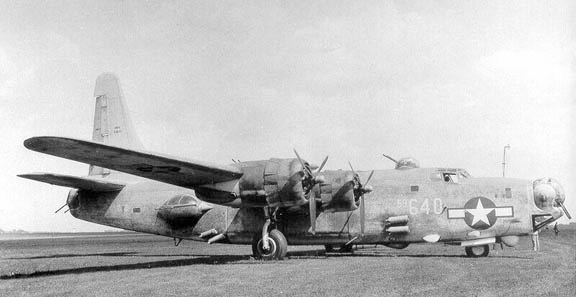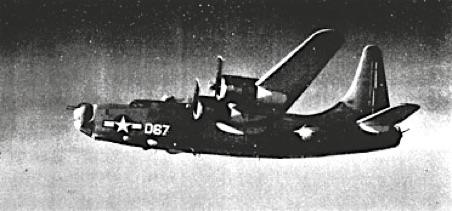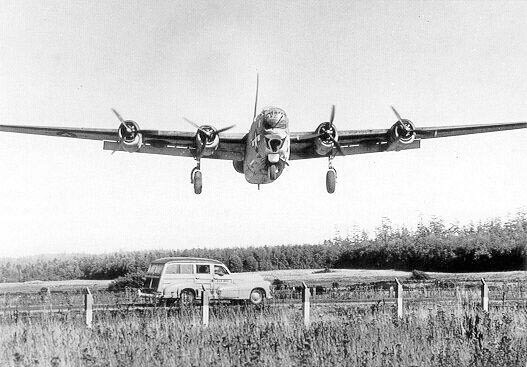
P4Y-2 Privateer
Consolidated P4Y-2 Privateer
The Consolidated PB4Y-2 was derived from the B-24 Liberator and used in the US Navy as a patrol bomber. The Navy originally used the B-24’s under the name PB4Y-1 Liberator, but soon wanted their own version. So, in 1943 Consolidated came up with a long range patrol bomber; the PB4Y-2 Privateer. What was omitted for the PB4Y-2’s were the turbosuperchargers (since they would not be flown at a high altitude), and the twin tail to a single vertical tail. The defensive armament was also increased on the PB4Y-2 adding a second Martin dorsal turret and two ERCO waist blisters.


The Navy, now very happy with their new and improved aircraft, ordered 1,370 Privateers and the first Privateer deliveries began in March of 1944. The last were delivered in October of 1945 totaling 739. The remaining 631 ordered were cancelled following V-J Day (Victory over Japan Day)
The Privateer entered Navy service during late summer, 1944. The PB4Y-2 was used exclusively in the Pacific Theatre for patrol missions supporting water/land based operations during WWII. They flew up to 16 hour operations in support of the invasion of Iwo Jima, and other missions included: Searching out enemy radar, radio/navigational stations and destroying them, searching out troop ships, land targets, and sea targets. They reported on weather, on enemy positions/actions, located downed airmen, and coordinated the rescue operations. They also provided cover for the B-29 missions against Japan.

Following WWII on June 25, 1950 when the Korean War started, PB4Y-2’s were used in numerous patrol missions, searching for North Korean or Chinese seaborne infiltrators.
Post 1951, the PB4Y-2 Privateer aircraft still in service dropped the “B” in their name and were designated P4Y-2.
The P4Y-2 has a length of 74 feet 7 inches, a wingspan of 110 feet, and a height of 30 feet 1 inch. It manned 11 crew; 2 pilots, 1 navigator, 1 bombardier, 5 gunners, and 2 radio operators. The Privateer supported four Pratt & Whitney R-1830-94 radial engines (1,350 horsepower each), reaching max speeds of 247 mph. The cruising speed was 175 mph. and the range of the P4Y-2 was 2,820 miles.
The Consolidated P4Y-2 Privateer could hold up to 12,800 lbs. of bombs, mines, or torpedoes, and located in six spots (two on top forward and aft, one on each waist, one nose and one tail) a pair of .50 inch M2 Browning machine guns.
On August 26, 1956 a P4Y-2 Privateer was sitting at NAS Seattle at Sandpoint awaiting take-off for a 2 ½ hour training flight. Lt. Thorson (pilot) and Lt. Shook (co-pilot) were delayed at 9:30 am due to marginal VFR (Visual Flight Rules) conditions. In the meantime, until weather improved, the two were briefed to conduct GCA (Ground Control Approach/Airborne) runs and remain on the ground. Lt. Thorson checked the Privateer, assembled and briefed his crew, then went through pre-flight procedures. In addition to the delay from the weather, a circuit breaker went out and caused yet another delay.
Probably getting pretty frustrated at this point, the P4Y-2 was finally ready to taxi to the warm up area on runway 14 at 10:15 am. But as luck would have it, the visibility decreased again and yet another delay was upon them. In the meantime the pilots went through the engine run-up and take-off checklist. Somehow while doing the pre-flight checks the flaps were overlooked, and in the wrong position.

At 10:25 am the visibility improved and at 10:27 the Privateer was cleared for take-off. Lt. Thorson positioned the plane for take-off at 10:33 and completed the “In position for take-off” checklist. The P4Y-2 started down the runway gaining speed.
When a plane is gaining speed down a runway it uses what is called “ground effect” to help in the process of taking off. With the flaps in the wrong position, the Privateer left the runway (about two feet up) and was immediately over the water (about a ten foot drop to the water). It then lost the ground effect and didn’t have the help from the flaps to gain altitude, it immediately settled down to the water going approximately 110 knots, 300 feet away from the end of the runway, and then skimmed about 5,000 additional yards away from the initial impact point.
Normal ditching procedures followed and all personnel on board exited the aircraft within about 45 seconds. With crew in life rafts, they sat and watched the Privateer sink within 3 minutes to the bottom of the lake in 175 feet of water. There were only minor injuries on Lt. Shook and one crewman, from exiting the plane.
Damage to the aircraft was minor. The propeller blades were slightly bent from the impact, and the bomb bay doors were ripped open and one bomb bay tank was ripped loose from the plane.
Salvage attempts started on August 28, 1956, and the plane was raised from the dark bottom on the 31st. In the process of towing to shore bad luck once again shined down on the P4Y-2. A shackle pin broke on the hoisting sling and the Privateer was once again sent down to the depths in 165 feet of lake water. When the pin broke, the lines that were connected to the inboard engines ripped the engines totally off their mounts. Future salvage efforts were abandoned, because it was not economical.






-
-Home
Below footage from Ben Griner and Puget Sound Divers
